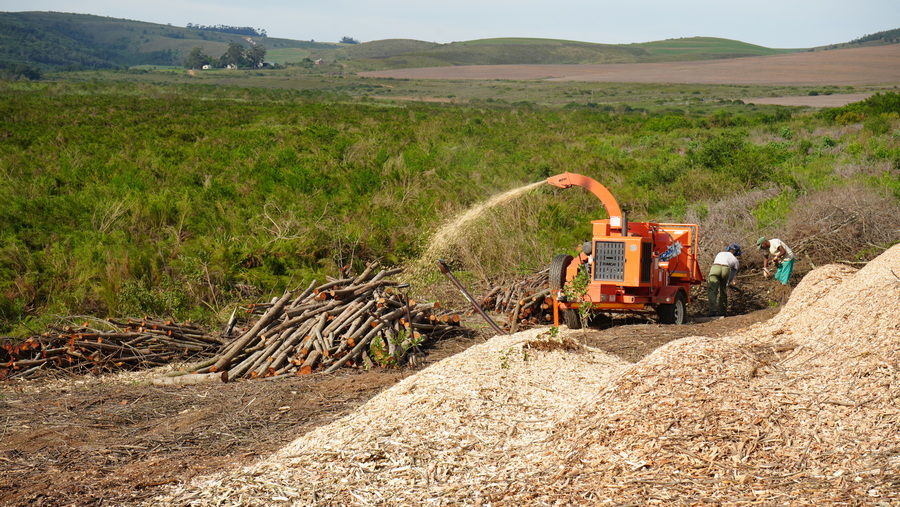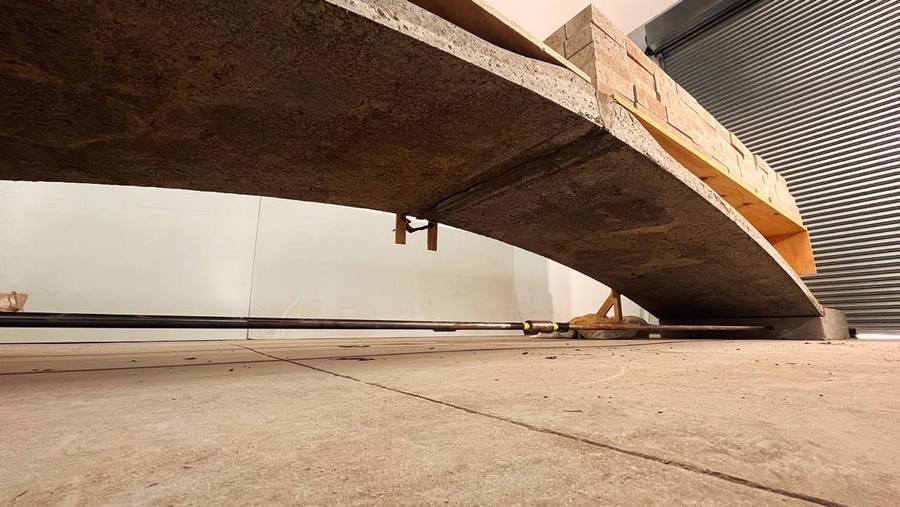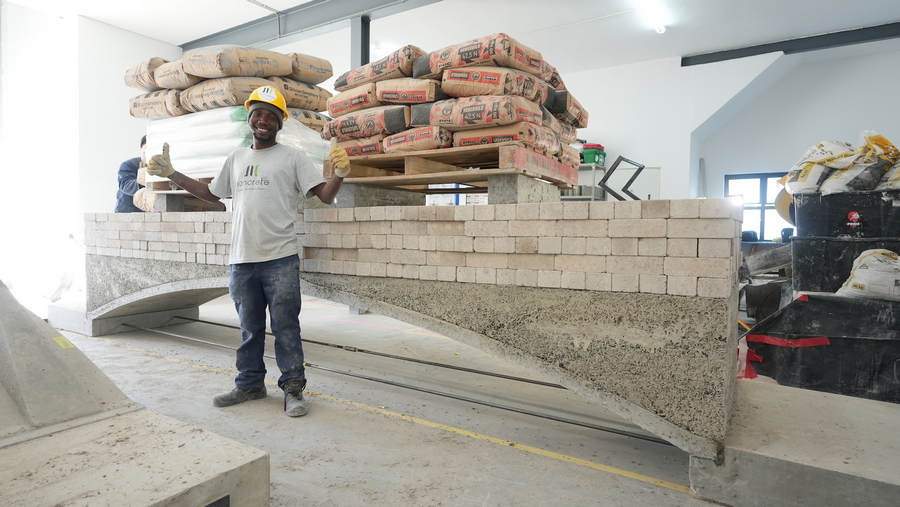Millions of people are still awaiting their government-funded homes, and developing affordable, sustainable, dignified housing in South Africa remains an unrelenting need.
Addressing this is a highly innovative collaboration between the Cape Town-based company nonCrete; the Institute of Technology in Architecture at ETH Zurich, Switzerland; and the Council for Scientific and Industrial research (CSIR). They have come up with a potentially game-changing design and construction methodology for safer, more dignified housing alternatives.
The design is a circular economy approach that addresses multiple issues, including safe and dignified housing, alien invasive vegetation, South Africa’s freshwater shortage, job and SMME creation, carbon footprint reduction, and reducing the use of steel, sand and cement.
The methodology is being pursued in a 3-year project co-funded by the WWF Nedbank Green Trust and the CSIR’s Circular Economy Demonstration Fund. Called ‘alien biomass to housing’, it started in April 2024 in partnership with nonCrete, the non-profit Phuhlisani, and the Elandskloof community near Citrusdal in the Western Cape.
The Elandskloof community lives on a farm that was restituted to its approximately 500 inhabitants under the land reform process. They were dispossessed of their land in 1962 by the apartheid government and it was returned to them in 1996. Nearly 30 years later the residents are still living in informal dwellings. For the Elandsklowers this project has the potential to change their lives and they are engaged in its every stage, starting with a pilot 8 m x 8 m crèche to demonstrate the non-Crete method.
Stephen Lamb from nonCrete explains: ‘The bricks are the size of conventional bricks but they are made from the biomass of local alien invasive trees that are felled from the riverbanks, put through a chipper, and combined with a specially developed binder to create a low-carbon material.’ Lamb and nonCrete co-founder Andrew Lord have worked on sustainable construction, design, engineering and architecture for 24 years.

Alien invasive tree chipper
Elandskloof is situated in the valley of the Groot Winterhoek Strategic Water Source Area (SWSA), one of 22 key water sources for South Africa. Its riverbanks are full of black wattle and the removal of alien invasive trees within a 50 km radius will have huge impact in freeing up available freshwater.
Making use of the alien invasive biomass, the nonCrete method significantly reduces the amount of stone, sand and cement used in standard concrete bricks. The bricks also have a higher degree of fire resistance and superior thermal qualities, helping to keep homes warm in winter and cool in summer.
In addition to the bricks, nonCrete has also developed a vaulted floor and roof system developed in collaboration with the CSIR and the Head of the Institute of Technology in Architecture at ETH Zurich, Professor of Architecture Philippe Block. ‘This is an exceptional design that follows the motto of “strength through geometry”’, says Prof Block.

nonCrete’s vaulted floor system. Photo: nonCrete
‘It is inspired by the arches constructed by master builders in the Gothic cathedrals of Europe that are still standing 500 years later and which we are using in European design,’ Prof Block explains. ‘The floor and roof system significantly reduces the amount of steel and concrete required and has 75% lower carbon emissions than a conventional concrete flat slab. It complies with Eurocode load requirements for multilevel construction in residential, office and other buildings.’

Head of the Institute of Technology in Architecture, ETH Zurich, Professor of Architecture, Philippe Block. Photo: Elisabeth Real
‘In my 15 years with WWF, this is one of the most exciting projects I have been part of in terms of its socioeconomic and environmental impact, and the quality of the design and building materials makes it desirable across the economic spectrum,’ says Helen Stuart, WWF’s programme manager for Partnership Development and Knowledge Sharing in the Freshwater Portfolio, who is coordinating the project for the WWF Nedbank Green Trust.
Once the demonstration crèche has been constructed, the Elandskloof Communal Property Association (CPA) members can decide if they would like to use this method to construct their homes.
‘We are currently helping facilitate negotiations with the municipality and the provincial and national departments for the application of the housing subsidies to pursue the larger housing project,’ says Phuhlisani’s David Mayson, who liaises with the community, the local and district municipalities, the Department of Human Settlement, and other government departments.
Community members would be trained in alien invasive tree clearing and wood chipping, brickmaking on-site and the construction method, which would create self-employment and SMMEs for women and men in Elandskloof, where the vast majority of people are unemployed.
‘We are also assisting the Elandskloof community with an integrated development plan on this wonderful piece of land, including developing the agricultural side,’ Mayson explains. ‘The land is currently used only by about 5 small-scale farmers. Originally, there were about 30 hectares of fruit trees, and these could be planted again. They currently harvest indigenous plants like wild buchu, which grows abundantly here and for which there is market demand.’
The entire nonCrete process is submitted to Agrément South Africa for the necessary certification and to demonstrate that the construction techniques exceed all regulatory requirements. Agrément South Africa evaluates non-standardised construction products, materials, and systems against strict performance-based criteria, including strength, durability and fire resistance.
‘We’re excited to see how catalytic this low-emission building system can be as it has vast potential and is increasingly gaining ground in research and construction locally and internationally,’ says Poovi Pillay, Executive Head of Corporate Social Investment at Nedbank. ‘The methodology has the potential to be duplicated across the country, starting in Elandskloof, and replace conventional, carbon-heavy building materials and practices. What is so effective is that carbon absorbed by the trees is locked into the buildings.’
Prof Block explains that robust, low-cement building materials and super-efficient, low-emission and resource-efficient building systems are urgently needed worldwide. ‘Considering that there will be 2 billion more people on the planet 30 years from now, if we were to provide adequate housing and infrastructure for the world’s population using conventional construction materials and systems, we would have to build the equivalent of 1 New York City every month for the next 40 years.
‘This is what appeals to me about nonCrete’s methodology,’ says Block. ‘It aligns with the urgent need worldwide to change the way we design and build our structures and to disrupt the concrete, steel and carbon-intensive construction technologies for architecture. The exciting part is that with this Elandskloof project we are taking a great idea and making it happen.’
Dr Coralie van Reenen, research group leader of Infrastructure Innovation at the CSIR, says “this project is an opportunity to demonstrate the principles of a circular economy in practise and promote the uptake of innovation for sustainable human settlements.” The circular economy is a key area of research with enormous potential to impact environmental sustainability and resource efficiency, and is particularly relevant in the built environment, which is cited as contributing almost 40% of global greenhouse gas emissions.
The co-design and construction of the Elandskloof crèche will provide a demonstration site not only for the community, but also for research practitioners, construction companies, cement manufacturers, planners, architects, engineers, municipalities and other government departments.
In addition, the methodology creates jobs for those who need them most, and helps to restore South Africa’s water factories (the SWSAs). Stuart explains that the prevalence of alien invasive plants in South Africa’s SWSAs remains one of the biggest threats to the country’s water supply.
SWSAs cover less than 10% of South Africa’s land surface but provide more than 50% of the entire country’s water. A significant collaboration is in the process of finalising strategies to secure the all-important high-water yield SWSAs. This pilot project using alien invasive plants contributes to their thinking and strategies.
The collaboration includes the Department of Forestry, Fisheries and the Environment; Department of Water Affairs and Sanitation; the South African National Biodiversity Institute; the Water Research Commission; the CSIR, and WWF.
‘Our goal is to share this technology and acquired knowledge with South Africa and, where requested, to train people to build their own houses in all areas with an abundant supply of alien invasive tree species, which applies to many parts of the country,’ says Lamb. ‘We have been collaborating with One-Nil Construction, led by Grabeth Nduna who has a developing BEE SMME enabled by nonCrete, the CSIR and WWF SA, and to whom we subcontract skills development and work opportunities. Nduna and 2 other members of the nonCrete team, Peter Mafuwe and Mojalefa Thelingoana, have been pivotal in creating the material mix designs we require.’

Peter Mafuwe of the One-Nil construction team who does the material mix design for the vaulted floor. Photo: nonCrete
The team is currently engaging with the Elandsklowers on the final co-design of the creche with their full input as to what they need it to include and look like. Flooding in the region delayed the process as the area became inaccessible, but once construction has started, the project team will at the same time be doing a life cycle assessment of the building and construction process to calculate the total carbon footprint of the crèche.
If the community decides this is the method they wish to use for their housing, Phuhlisani, nonCrete and the CPA committee will engage with the required authorities on the granting of housing subsidies to be used according to this methodology, with community members trained to build their own houses.




